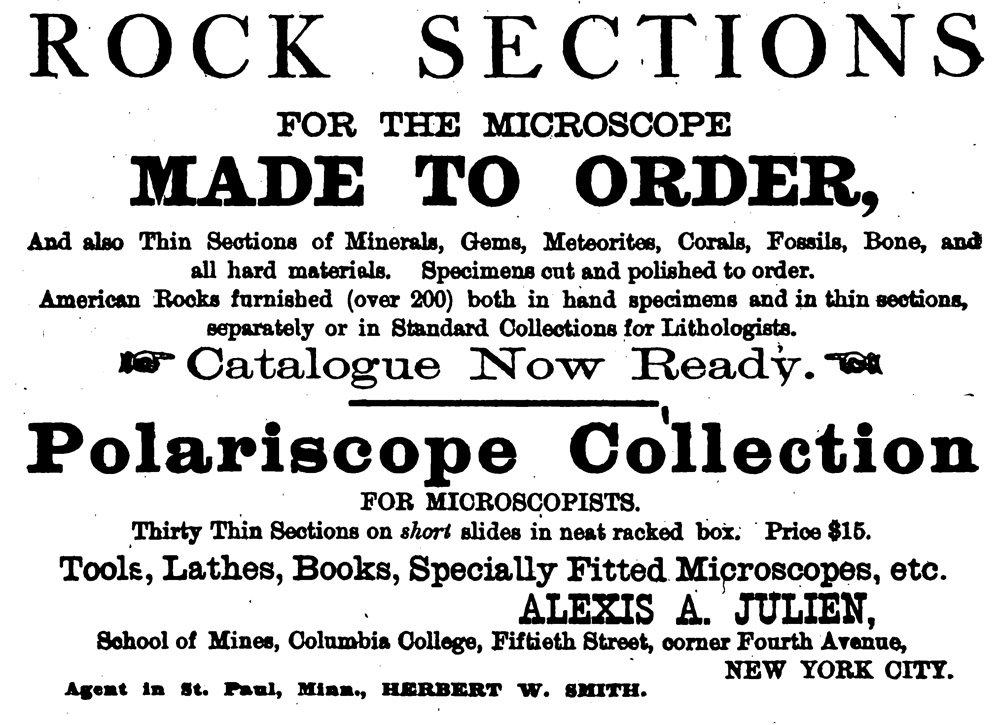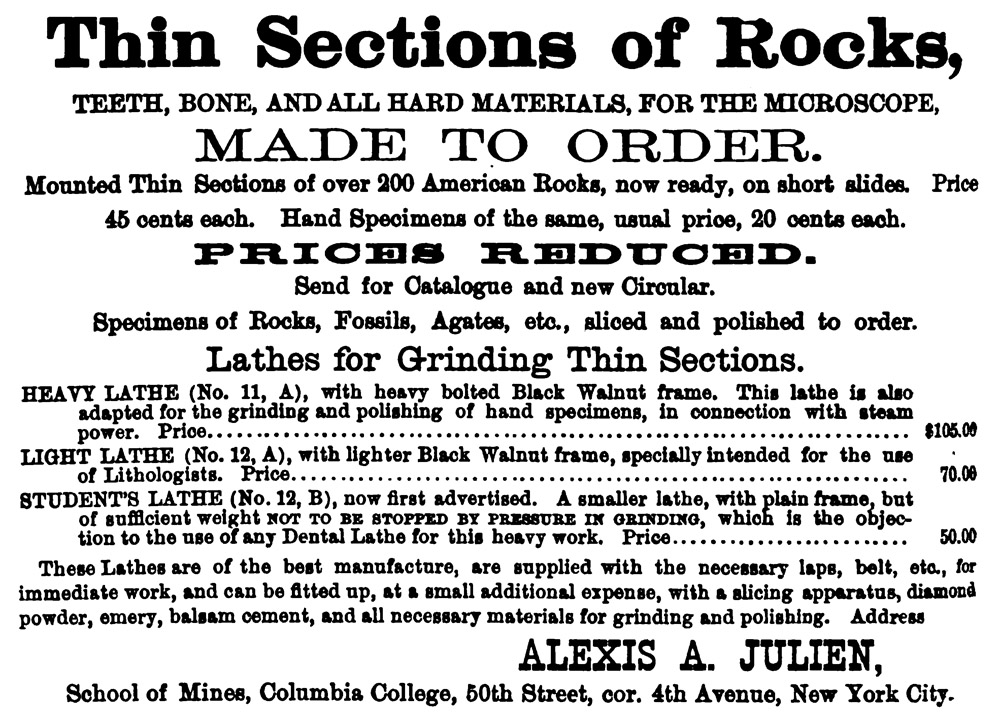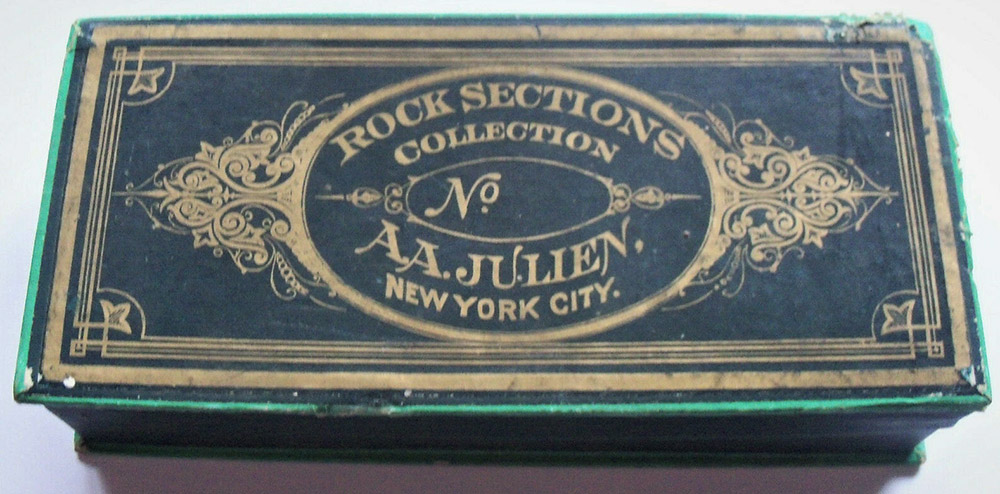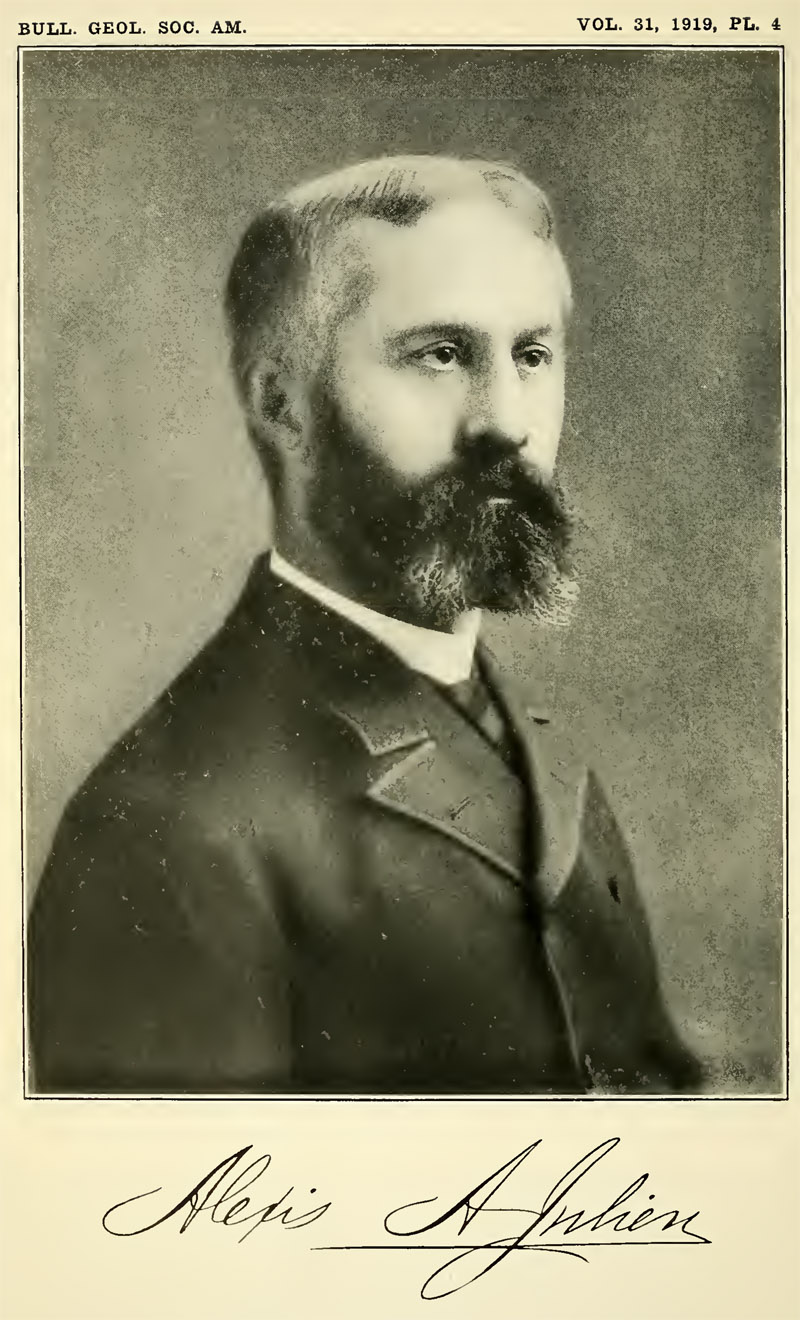Alexis Anastay Julien, 1840 – 1919
by Brian Stevenson
last updated March, 2020
Microscope slides that were produced by 19th Century Americans are not often
encountered in auctions or in many people’s collections. One possible reason is that many modern collectors are not very familiar with early American mounters. The most significant reference book on early slide-makers, Brian Bracegirdle’s Microscopical Mounts and Mounters, is
heavily geared toward English mounters, an understandable bent for an English
collector such as Dr. Bracegirdle. An unfortunate side effect, though, is that
even American collectors tend to focus on English microscopists, and neglect
our native mounters. Yet there were many Western Hemisphere makers of
microscopes and slides who were highly acclaimed on both sides of the Atlantic
during the Victorian era. Their high quality productions should be welcome in
any collection. It is my hope that by raising awareness of the excellent slides
crafted by skillful Americans, Canadians, and others, general interest will
increase among collectors and stimulate current owners to make such slides more
readily available.
Among the
finest early U.S. slide makers was Alexis Julien. He was a Professor at the
Columbia College School of Mines (New York) and a noted expert on many aspects
of chemistry, geology and mineralogy. Julien was a founding member of the New
York Microscopical Society, and was a Fellow of the Royal Microscopical Society.
He was also a professional maker of thin-sectioned mineral microscope slides,
producing slides that are on par with those of the best English and European
lapidaries of the Victorian era (Figure 1). Julien was producing and selling
mineralogical slides by 1878, offering both pre-made and
custom slides (Figures 2-6). In addition, he sold microscopes customized for
mineralogy, mounting supplies, lathes, and all sorts of tools for the
rockhound.

Figure 1.
Lapidary microscope slides prepared by Alexis
Julien. He produced both standard 1 x 3 inch slides and smaller, 1 x 2 inch
slides. Julien’s name is in very small print on the side of the 1 x 2 inch
slide’s upper label. Those “short” slides were also favored by German
lapidaries of the era. The mineral serpentine was a major focus of Julien’s
academic research.

Figure 2.
An 1878 advertisement by A.A. Julien, from ‘Science News’.

Figure 3.
An 1878 advertisement from ‘The American Journal of Microscopy and Popular Science’.

Figure 4.
Another 1878 advertisement from ‘The American Journal of Microscopy and Popular Science’.

Figure 5.
An 1878 advertisement from ‘The International Naturalists’ Directory’.

Figure 6.
A customized box for Julien’s 1 x 2 inch slides. Adapted for nonprofit, educational purposes from an internet auction site.

Figure 7.
Undated photograph of Alexis A. Julien. From his 1919 Bulletin of the Geological Society of America memoriam.
Details of
the life of Alexis Julien are best provided by his colleague James Kemp, who
wrote the following memorial shortly after Julien’s death:
“In the loss of Alexis
Anastay Julien May 4, 1919, the Fellowship of the Geological Society was diminished by one of the pioneer
American petrographers, if indeed he was not actually the very first of
American-taught users of the polarizing microscope. His report on the lithology
of 259 rocks from the Huronian and Laurentian of the Upper Peninsula for volume
II of the Michigan Geological Survey, published in 1873, is, so far as known to
the writer, the earliest contribution in which this indispensable aid to
investigation was employed in this country. In the subsequent years of the decade of the seventies, those
American students who followed microscopic petrography in the more advanced
courses of our colleges were trained upon sets of slides and collections of
rocks emanating from Dr. Julien's laboratory. In these latter days of the
universal employment of thin sections we may hark back in respectful and appreciative
memory of one who blazed a pioneer trail through regions then unexplored.
Dr. Julien was born in
New York, February 13, 1840. His father, Pierre Joseph Denis Julien, had come
to America from Lourmarin, Provence, France; while his mother, Magdalene Cantine,
was a member of an old Huguenot family, long settled in Ulster County, New
York. The parents educated their son at the Mount Washington Collegiate
Institute in New York, and from it, in 1856, entered him as a sophomore in
Union College, where he graduated in 1859, salutatorian of his class. He was
elected to Phi Beta Kappa, and, having manifested the special interest in
chemistry which he never lost during his later years, he was appointed
assistant in the chemical laboratory the following year, under Prof. Charles F.
Chandler.
In July, 1860, Alexis
Julien became chemist of a company exploiting the guano deposits of the island
of Sombrero, in the West Indies, and passed the next four years in its service.
He had peculiar advantages for the study of the natural history of the lime
phosphates and of the reactions produced by waters descending through bird
guano to encounter limestones lower down. The year following his return to New
York we find the results of his observations published in the American Journal
of Science, as cited below in the first contribution of his bibliography. While
on the Key of Sombrero he also studied the birds and shells and sent
collections to the Smithsonian Institution. He likewise kept meteorological
observations for the Smithsonian's records, maintaining thus the most southern
of its stations. In 1862 he made a geological survey, for the Swedish
Government, of the islets around the island of Saint Bartholomew, West Indies,
and forwarded his report to the governor, Carl Ulrich. In 1863 he received from
the King of Sweden the gold medal which is given by that monarch to those whose
work deserves it - ‘Illis quorum meruere labores.’ He returned to New York in
1864 and prepared for publication
the results of his observations in the West Indies. Union College gave him the
degree of A.M. in the same year.
In 1865 he was appointed
assistant in charge of the quantitative laboratory, in the recently established
School of Mines of Columbia College, to which his old chief at Union, Dr.
Charles P. Chandler, had been called. In the same year he became a member of
the New York Academy of Sciences, then the Lyceum of Natural History, and was
an active worker in it all the rest of his life. In the last five years of the
sixties microscopical petrography, first developed by H. Clifton Sorby, in
England, had its chief nurture and expansion under Ferdinand Zirkel, then in
Vienna. By 1872 Alexis Julien had mastered its methods of work and undertook
the studies for the Michigan Survey mentioned in the opening paragraph above.
In 1875 he undertook a similar engagement for Prof. W.C. Kerr, State Geologist
of North Carolina, and spent three successive summers in the field. A very
detailed report resulted, which has been the subject of revision in recent years, so as to bring it within
the means of publication of the North Carolina Survey, and is stated to be now
in process of issue.
Although attached to the
Department of Chemistry, Dr. Julien thus became more and more drawn away from
chemical research by his interest in the microscopic study of rocks and in the
investigation of geological phenomena. In 1880 he published one of his most
important and most widely quoted papers, ‘On the geological action of the humus
acids,’ in the Proceedings of the American Association for the Advancement of
Science. The paper was of unusual value in bringing to the attention of
observers the work of this little appreciated agent in the weathering of rocks.
In 1881 he reverted to
his early studies of the guano deposits of the West Indies, and visited the
islands of Bonaire, Curaçoa, and Aruba, West Indies, making a study of the
guano resources and of their general geology. At the commencement of 1882 the
degree of Doctor of Philosophy was conferred upon him by New York University.
During this period Dr.
Julien was also preparing an extremely important report for the Tenth United
States Census, on ‘The durability of building stones in New York City and vicinity,’ which is published in
volume X of its reports. This larger report was suggested by several shorter
contributions … and in the end led to the investigation of the causes and cure
of the alarming disintegration of New York's priceless relic of antiquity, the
Egyptian obelisk, one of the features of Central Park. In these early years of
the decade of the eighties, Dr. Julien became interested, along with his friend
the late H. Carrington Bolton, in the curious musical note given out by certain
beach-sands under the pressure of footsteps, a note which has attached to them
the name ‘singing sands.’ A very extensive collection of sands from, one might
almost say, all over the world was made for investigation and several
contributions resulted on their microscopic characters. Soon afterward Dr.
Julien took up the study of the two species of sulphide of iron, pyrite, and
marcasite, especially with regard to their decomposition, and several papers
were published which have been much quoted. While many geologists were more or
less thoroughly convinced of the organic nature of Eozoon canadense, Dr.
Julien's petrographic studies led him very early to the conclusion that it was
a purely inorganic product of contact metamorphism; but his interest became
excited in the development of serpentine, and continued active all the rest of
his life. Years afterward he brought out the importance of brucite, deweylite
and some minor transition products, and serpentine became the subject of his
later labors. He had prepared a manuscript embracing the results of many years
of reading and investigation, which was unfortunately destroyed in a fire which
consumed his home, just a week before his death.
Having become
transferred in 1898 from the Department of Chemistry in Columbia University to
the Department of Geology, at the time the university removed to its present
site, he entered into the discussions which were active in the meetings of the
officers and students of the latter. Among these the recasting of the analyses
of rocks was one. Prompted by his studies of the serpentines, Dr. Julien was led
to apply the methods of recasting to the analyses of a variety of doubtful
species of minerals and with extremely fruitful results, which are set forth in
his paper on ‘The determination of mineral constitution through recasting of
analyses’ (1908).
In the above review the
endeavor has been made to emphasize the subjects to which Dr. Julien made
contributions of especial importance. Perusal, however, of his bibliography
will show a number of other topics on which he wrote. His interest was
especially keen in microscopic work and he was one of the original founders of
the New York Microscopical Society, in 1880. He was one of the original members
of the American Society of Naturalists at its establishment, in 1883. In 1878
he was elected honorary member of the Louisville Microscopical Society and in
1889 was made Fellow of the Royal Microscopical Society. He became Fellow of
the Geological Society of America in May, 1889, in the second year of its
organized activities.
Upon retirement from
active university work, at the age of seventy, Dr. Julien vigorously continued
his scientific work and was busy with his writings up to his final illness. The
disastrous fire which destroyed his home, as mentioned above, played havoc with
the results of years of work. It is tragic that they could not have come to
issue while yet he was able to see the fruition.
In 1882 Dr. Julien
married Annie Walker Nevius, daughter of the late Peter J. Nevius, of New York
City, and still living at their home of recent years in South Harwich,
Massachusetts. To Mrs. Julien the writer is greatly indebted for incidents in
the life of her husband, which have supplemented a personal friendship of
nearly forty years.”

Figure 8.
Title page of an 1893 work by Julien.
Resources
American Journal of Microscopy and Popular Science (1878) Advertisements by A.A. Julien, Vol. 3
Bolton, H. Carrington and Alexis A. Julien (1885) Musical
sand, its wide distribution and properties, Proceedings
of the American Association for the Advancement of Science, pages 408-413
Cassino, Samuel E. (1878) The Naturalists’ Directory (International), Advertisement by A.A.
Julien at the back of the book
HistoricMeteorites.com (accessed May, 2013), Mystery Alexis A. Julien 19th Century thin-section, http://www.historicmeteorites.com/I-Iowa.html
Journal of the Royal
Microscopical Society (1889) Election of Alexis Julien, January 9, 1889,
page 168
Julien, Alexis A., and H. Carrington Bolton (1885) Notice on
the microscopical examination of a series of ocean, lake, river and desert
sands, Proceedings of the American
Association for the Advancement of Science, pages 413-415
Julien, Alexis A. (1885) A study of “Eozoon Canadense”, Proceedings of the American Association for
the Advancement of Science, pages 415-416
Julien, Alexis A. (1886) The
Microscopical Structure of the Iron Pyrites, New York Microscopical Society,
New York
Julien, Alexis A. (1893) Suggestions in microscopical
technique, Journal of the New York Microscopical
Society, Vol. 9, pages 23-43
Julien, Alexis A. (1893) Notes
of Research on the New York Obelisk, New York
Kemp, James F. (1919) Memorial of Alexis Anastay Julien, Bulletin of the Geological Society of
America, Vol. 31, pages 80-88
Science News (1878)
Advertisement by A.A. Julien, Vol. 1, November issue
Wilson, Wendell E. (accessed May, 2013) Alexis Julien,
Mineralogical Record Biographical Archive, at www.mineralogicalrecord.com







